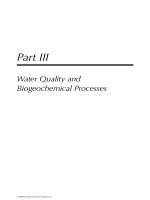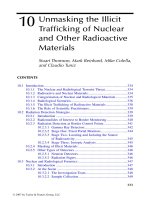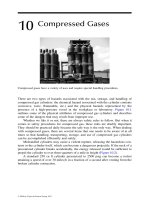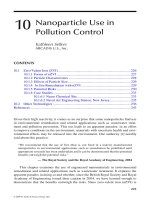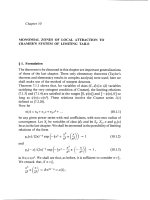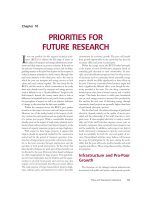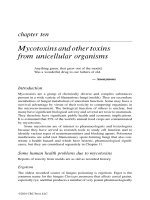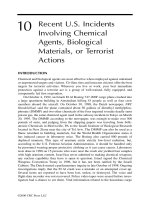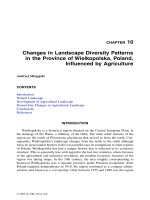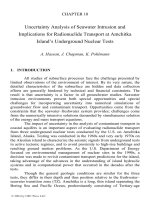Interactions Between Agroecosystems and Rural Communities - Chapter 10 pot
Bạn đang xem bản rút gọn của tài liệu. Xem và tải ngay bản đầy đủ của tài liệu tại đây (407.25 KB, 25 trang )
A Learning Approach
to Community
Agroecosystem
Management
Clive Lightfoot, Maria Fernandez, Reg Noble,
Ricardo Ramírez, Annemarie Groot,
Edith Fernandez-Baca, Francis Shao,
Grace Muro, Simon Okelabo, Anthony Mugenyi,
Isaac Bekalo, Andrew Rianga, and Lynette Obare
CONTENTS
Introduction
A Learning Approach
First Dimension:Organizational Structure for Learning
Second Dimension:Process for Learning
Third Dimension:Instruments for Learning
Learning Instruments for Future Visioning of Agroecosystem Management
Learning Instruments for Clarifying Requirements, Partnerships,
and Responsibilities
Learning Instruments for Clarifying Characteristics of Successful
New Partnerships
Learning Instruments for Reflecting on Agroecosystem Performance
Learning Instruments for Reflecting on Partnership Performance
Conclusion
References
INTRODUCTION
Farmers, local extension workers, and nongovernment organization (NGO) field staff
play increasingly more important roles in “community-based” agriculture and natural
resource management projects or programs. Ideas about priority problems and how
they might be solved are expected to come from the community. A bottom-up, par-
10
© 2001 by CRC Press LLC
ticipatory approach to project design and implementation is the operational hallmark
of these projects.
Communities rife with conflicts over the exploitation of farmland and natural
resources are suddenly expected to work together to conserve nature. Suddenly, farm-
ing systems that degrade the soil and pollute water resources are expected to become
ecologically sound and government and nongovernment institutions that have had lit-
tle experience working together are asked to form partnerships.
Although no one doubts the desirability of these changes, little time and few
resources are given to bring them about. Project participants are given no time to
understand the perspectives of different communities about agroecosystems and their
management. Indeed, little effort is given to finding out who the stakeholders are, let
alone time for negotiating concerted action in the management of agroecosystems.
No one should really be surprised when project evaluators report that most farm-
ers are not participating in the project, and that few will continue after the project
ends. Equally, no one should be surprised when the expected farming or conservation
improvements have not been realized. Farmers often are not impressed with the
impact of so-called “improved” technologies. They complain that funds are attached
to technological fixes that are inappropriate. Little effort is given to the development
of knowledge systems for ecologically sound agriculture. Traditional knowledge
about ecologically sound practices is rarely documented in a manner that is useful to
other farmers. Project participants are rarely plugged into the growing international
knowledge system of organic, ecologic, or alternative agriculture.
There is little room in projects for learning and change. External monitoring and
evaluation, the main opportunities for adjustments, usually provoke defensive atti-
tudes in which mistakes are hidden rather than used as opportunities for learning.
Because local people do not have the capability or responsibility for evaluation, valu-
able lessons go unlearned. Because local people remain isolated from external
knowledge networks, more appropriate technologies go unused.
To complicate matters further, many African nations are decentralizing and pri-
vatizing much of their public sector agriculture support services. District level staff
are now asked to respond to farmer demands and to form partnerships with other ser-
vice providers to meet those demands. The logic behind these policies is not only to
save government money through sharing tasks and narrowing responsibilities, but
also to provide better targeting of services and more efficient services. Building
viable interinstitutional partnerships is hard, slow work. Moreover, responding to
farmer demands requires considerable flexibility and dynamism of those organiza-
tions. How to create farmer demand for services and how to form viable partnerships
rarely are subjects of study. There are few success stories and best practices on which
to build. In these circumstances, the challenge confronting donors, central and local
government officers, and project participants is to invent their own ways of working.
This is partly because local conditions and complexities require a level of on-site
innovation that cannot be satisfied by emulation of “best practices.” This is not to say
that the proverbial wheel must be reinvented everywhere, but best practices do need
to be adapted to local conditions, or better still, re-invented by local people. A capac-
ity to re-invent and innovate is essential to partnership building and community
progress in agroecosystem management.
© 2001 by CRC Press LLC
In this chapter, the authors describe how a learning approach provides commu-
nities, local government, and agriculture service providers with opportunities to learn
their own way through to better partnerships and better management of agroecosys-
tems. They describe an organizational structure for learning, a process for learning,
and several key instruments to facilitate learning. The chapter is concluded with a
look at what progress has been made in community development of agroecosystem
management strategies, farmer demand for agriculture support services, formation of
partnerships, and capacity for local innovation. The conclusion ends with a brief look
at the constraints to further development of a learning approach to community-level
agroecosystem management.
A LEARNING APPROACH
A learning approach builds joint capacity among community members, field-level
development workers, and service providers for local on-site innovation. Learning
facilitates innovation in the way local people work together and how they assess the
performance of their partnerships and their agroecosystem management strategies.
Enhanced innovative capacity sets the stage for improving the management of agroe-
cosystems and the effective demand by farmers on agricultural support services. It
also sets the stage for handing over more responsibilities to local actors at every stage
of the project cycle from design through evaluation.
The learning approach developed in this discussion draws on four lines of
research. Research in the area of farmer participatory development provides a great
deal of experience in how to engage farmers in research and development projects
(Chambers, 1997; Korten, 1980; Pretty et al., 1995). Insights gained from research on
learning systems and soft systems provides a second foundation for this work
(Bawden, 1991; Checkland and Scholes, 1990; Daniels and Walker, 1996).
Operational details have been greatly informed by research in the areas of agricultural
knowledge and information systems analysis (Engel and Salomon, 1994; Ramírez,
1997), multiple stakeholder management in forestry, and protected area management
(Borrini-Feyerabend, 1996; Daniels and Walker, 1996; Ramírez, 1999). On the bio-
logic side, operational details have been informed by research in the areas of agro-
ecosystem analysis (Altieri, 1989; Conway, 1985; Lightfood and Noble, 1993;
Lightfoot et al., 1993). The research methods of agricultural knowledge and infor-
mation systems assessment have been woven with the research methods of agro-
ecosystems analysis to capture both the learning about the way stakeholders are
organized to respond to complex situations and the agroecologic aspects (Altieri,
1989; Conway, 1985; Lightfoot and Noble, 1993; Lightfoot et al., 1993).
This research provided the theoretical and methodologic inputs into the devel-
opment of a learning approach that has engaged the International Support Group
(ISG) and its local partners in Kenya, Uganda, and Tanzania for the past 3 years
(Development Support Services, 1999; International Support Group, 1999; Shao et
al., 2000). This development attempted to insert a learning approach into the ongoing
development activities of a broad range of organizations at community, district, and
national levels. It is from these experiences that examples are drawn to illustrate three
dimensions of a learning approach. The first dimension described here is organiza-
© 2001 by CRC Press LLC
tional. It permits a comparison of organizational structures between research and
development projects. Process is the second dimension. This dimension elaborates a
process for learning. Instruments for learning make up the third dimension. These
instruments facilitate our learning about
• communities’ future visions of agroecosystem management and opportu-
nities for their realization
• partnerships and alliances needed if communities are to realize their visions
• negotiations to build partnerships and alliances for action
• reflections on agroecosystem management and partnership performance
they have.
FIRST DIMENSION: ORGANIZATIONAL STRUCTURE FOR LEARNING
Although organizational linkages in research and development projects vary enor-
mously, they have common patterns. Common patterns are, of course, oversimplifi-
cations, but they do make easier the kind of comparisons shown in Figure 10.1. Here
the organizational linkages in research and development projects are top down. Many
research projects build direct links between researchers working at the national level,
whether in a university or government research organization, and farmers. On-farm
experiments are found in many agriculture projects. Development projects, in con-
trast, involve extensionists from national and district levels and sometimes local
NGOs. Development projects work directly with groups of farmers. In both cases few
lateral links exist at the different levels. Where lateral links do exist, they tend to
be between research and extension at the district level and increasingly between
NGOs and extension at the point where the former are engaging the latter in their
projects.
In the growing number of community-based natural resource management pro-
jects, things are different. Here one finds linkages built among all relevant stake-
holders at the local, regional, and national levels. These projects tend to follow a
FIGURE 10.1 Linkages between participants in research, development, and learning settings.
© 2001 by CRC Press LLC
participatory action learning approach to development (Röling and Wagemakers,
1998).
A learning approach forges lateral links among organizations and groups at each
level and between levels. Over time, these linkages can result in the development of
informal interinstitutional learning coalitions. Local- or village-level learning coali-
tions need to bring together farmer self-help groups, community-based organizations,
and local government authorities. District-level interinstitutional learning coalitions
need to bring together representatives from NGOs, government research and exten-
sion agencies, local government authorities, and private sector agricultural service
providers. A similarly composed interinstitutional coalition also is needed at the
national level.
The learning approach framework also requires that different levels link together.
Local coalitions benefit greatly from linkages with district-level organizations.
District- and national-level organizations wishing to respond to community demands
benefit greatly from linkage with local learning coalitions. Opportunities occur from
time to time within projects and within the operations of local governance for dia-
logue between organizations at all levels and, although less frequently, for dialogue
between levels. However, without the commitment and resources of individuals
within the organizations concerned to continue meeting and learning, little progress
will result. Infrequent, random consultations or workshops are not enough to sustain
a learning approach. Moreover, without a clear process for learning and instruments
to facilitate learning, little progress can be made. Organizations seek new linkages
not for the abstract notion of learning, but to pursue their own goals. Linking and
negotiating are awkward, time-consuming efforts, but the organizations have come to
realize that no better alternative, especially in this age of decentralization. These are
the second and third dimensions, which are discussed next. Although the organiza-
tion for learning can be started within projects, it must move from project to project
in order to increase its skills and sustain itself.
SECOND DIMENSION: PROCESS FOR LEARNING
A number of elements were considered critical to effective joint learning:
• face-to-face accountability and group pressure to favor community influ-
ence
• farmer-led analysis, visioning, and planning
• reflection and adaptation of the instruments of learning
The process for learning has five distinct phases as shown in Figure 10.2. The
learning process allows the partners to analyze the performance of the partnerships
and find out where there is room for improvement. In this sense, “learning” embraces
a process of reflection in terms of the partnerships and the agroecosystem’s behavior
and performance.
The first phase starts at the local level with farmer self-help groups and
community-based organizations learning about the agroecosystems in their areas and
their management 30 years ago and today. Viewing from the past, local people envi-
© 2001 by CRC Press LLC
sion how they would like to change their agroecosystems in the future. The desired
changes form the basis for identifying the resources, services, and support needed to
realize their future visions. Local learning about better ways to manage agroecosys-
tems is enhanced by interactions with district- and national-level extensionists and
researchers.
These visions and the requirements of community members are presented to
district-level organizations in the second phase of the learning process. In this phase,
communities’ demands for agricultural support services are matched with the ser-
vices offered. This also provides an opportunity for community members’ visions to
be informed by district-level extensionists and researchers. Thus local- and district-
level organizations learn which services match demands and what new services
should be created to meet demands. Where demands go unmet, policy issues of inter-
est to national-level policy makers are raised.
When the resources, services, and support available match the community’s
requirements, there is a basis for negotiating partnerships between community mem-
bers and public or private sector groups, entities, or enterprises. In this phase, the
community and local organizations learn to develop partnerships that will increase
the community’s access to the resources, services, and support required to realize
their future visions of how their agroecosystem should be managed. Providing oppor-
tunities for private and public services to present the objectives and mandate of their
own organization and the constraints they face has proved to be an important aspect
for the negotiation of a good partnership.
After rounds of negotiations between partners, concerted actions occur. Action,
the implementation of improved agroecosystem management strategies, is the fourth
phase in the learning process. The hallmark of these actions is that
• they are directed toward a vision of the future fashioned by local people
• local people are the key actors in the implementation of the actions
• indicators of performance are established as the partnerships are
negotiated
FIGURE 10.2 Phases in a process of learning.
© 2001 by CRC Press LLC
These performance indicators are used to facilitate reflection, the fifth and last
phase in the learning process. After action or the implementation of projects, partners
at the local and district levels need to reflect on the performance of their partnership
and that of the agroecosystem management strategies. After reflection, district- and
local-level organizations revisit the community’s future visions of how agroecosys-
tems should be managed and what service partnerships are needed. Changes are made
as a result of what has been learned, and another cycle is started. Learning is a con-
tinuous process that has no end, as indicated in Figure 10.2.
THIRD DIMENSION: INSTRUMENTS FOR LEARNING
Learning instruments facilitate each phase of the learning process. These instruments
help the learners answer key questions. Each phase of a learning process has its own
specific set of key questions.
Phase 1:
• Future agroecosystem management strategies are envisioned and the
resources needed to implement them.
• What is the current status of our agroecosystem in comparison with the
past?
• What would we like to see our agroecosystem look like in the future?
• With whom do we need to partner to realize our vision?
Phase 2:
• Comunity members’ requirements are matched with accessible resources,
services, and/or support.
• What opportunities do the communities have to gain access?
• What new opportunities need to be created?
Phase 3:
• Providers and communities negotiate partnerships.
• What conditions facilitate the negotiation of effective partnerships?
Phase 4:
• Partners design strategies of action around areas of mutual interest and
implement their plans.
Phase 5:
• There is reflection on performance.
• What indicators will allow us to learn whether the improved agroecosys-
tem management practices and the newly negotiated partnerships are per-
forming well or not?
© 2001 by CRC Press LLC
The following section contains a brief description of learning instruments useful for
visioning, planning, negotiating, and reflecting on the phases of the learning process.
Each instrument is described and illustrated by examples from work done in Ghana,
Tanzania, Uganda, and Peru.
LEARNING INSTRUMENTS FOR FUTURE VISIONING
OF AGROECOSYSTEM MANAGEMENT
Maps are instruments that help communities to learn how the quality, quantity, and
use of the agroecosystems they manage have changed over the past 30 years, and to
visualize how they would like to manage and use them in future. Matrices can be used
to organize the information so that required resources, services, and support can be
used to identify the partnerships that will be needed to make the envisioned changes.
At the end of phase 1, a series of maps and matrices is available that provides infor-
mation on the current state and the intended future state of natural resources as well
as on the changes that need to be made and the kinds of partnerships that can help
bring them about.
Maps facilitate learning by allowing different groups with different interest, to
visualize how the agroecosystem has changed both for the better and the worse over
the past 30 years. They also allow community members to discuss with each other
and with outsiders, frequently government extensionists and researchers, what they
want their agroecosystems to be like in 20 years. These maps use local categories to
characterize farmland, forests, grazing areas, swampland and rivers, and other water
resources. They also include major landmarks such as community boundaries, roads,
houses, and other infrastructure. They indicate the major species of crops, livestock,
fish, and trees. The map of the future is a vision of all the new roads, houses, markets,
water supplies, and other infrastructure that communities would like to see. New
agroecosystem management strategies for the forests, croplands, grass, and swamp-
lands are represented on the completed map.
Matrices can help farmers organize the information on the current state of nat-
ural resources and contrast it with the changes needed to put improved management
strategies in place. Working from the present and future vision maps for each change
proposed, farmers identify the resources, services, and support they will need to
implement each change. Then a clear link is established between a requirement and
the kind of partnership needed to realize the improved agroecosystems management
strategy.
The examples of agroecosystem maps in Figures 10.3 and 10.4, prepared by
farmers from Soroti District in Uganda, clearly show an intention to intensify agro-
ecosystem management in the future (Development Support Services, 1999; Inter-
national Support Group, 1999). The current scattered farms with small plots of root
crops, few animals, and almost no trees will be replaced in the future with more
intensive farms that have a more diverse array of crops including coffee and upland
rice, zero-grazing cattle operations, fish ponds, and citrus orchards. It should be
noted that the expected rise in population is represented by a need for more houses,
© 2001 by CRC Press LLC
FIGURE 10.3 Agroecosystem map of the present situation, Soroti District, Uganda (Source:
From Development Support Services, Proceedings of on Orientation Exercise in Linked Local
Learning, July 2–3, 1999, DDS, Soroti, Uganda, p. 67.)
FIGURE 10.4 Agroecosystem map of the future vision, Soroti District, Uganda (Source:
From Development Support Services, Proceedings of on Orientation Exercise in Linked Local
Learning, July 2–3, 1999, Development Support Services, Soroti, Uganda, p. 67.)
© 2001 by CRC Press LLC
a school, a marketplace and bigger roads. The changes in the croplands noted on the
map are captured in a matrix of future changes and the partners needed to implement
them.
The matrix in Table 10.1 shows that grazing lands are to be rehabilitated by intro-
ducing improved pasture species and reducing the intensity of grazing with an
increase in zero-grazing operations. The wetlands are to be designated as conserva-
tion areas with irrigation facilities to enhance productivity.
The matrix indicates that a wide array of partners will be needed to provide the
necessary support and services. In addition to government services, there is a demand
for seed suppliers, credit services, and marketing agents as well. The matrix also
makes clear that to implement some changes, groups of community members will
need to form partnerships with each other. For example, conservation of wetlands,
management of grazing lands, and building of soil erosion measures all require
intracommunity partnerships.
As in the case of Soroti District, communities in the Quilcas District, Peru, used
participatory mapping to identify their desired future. Men’s and women’s groups
constructed their separate visions, which then were joined to arrive at a common
future vision for the community as a whole. Figure 10.5 shows the future vision of
the community of Colpar in 1998. The vision is that of improved livelihoods achieved
by way of sustainable agricultural production, good infrastructure, and tourism. The
vision proposes that strong community organization and a clear development plan are
critical to arriving at the vision. However, stronger organization and a clear plan
depend on building capacity at family and community levels so that the over time, the
elected authorities will be capable of facilitating collaboration among organizations
in the community. The community also will need to be effective in negotiating part-
Source: From Proceedings of an Orientation Exercise in Linked Local Learning, July 2–3, 1999,
Development Support Services, Soroti, Uganda.
TABLE 10.1
Future Changes in Agroecosystem Management and Key partners, Soroti
District, Uganda
Natural
Resource
Cropland
Grazing
land
Wetlands
Changes Management
Implement soil erosion control
measures, farm land con-
solidation
Introduce coffee, citrus, up-
land rice and fish ponds
Introduce improved pasture
species, better livestock
health, more zero grazing,
Implement conservation areas,
water dam construction for
irrigation.
Partners for Implementing Changes
Community, local government, Department of Agric-
ulture extension agents
Local government, Department of Agriculture ex-
tension, Department of Forestry, seed suppliers,
credit institutions, marketing agents
Community, local government, Department of Agric-
ulture Extension, veterinary services, NARO,
credit institutions
Community, nongovernment organizations local
council, Lands and Survey, Department of Agri-
culture Extension, credit institutions, marketing
agents
© 2001 by CRC Press LLC
FIGURE 10.5 Future vision for the community of Colpar in 1998 (Source: From Fernandez-
Baca, E. and Fernandez, M. E., Evalvando de las Estrategias de Desarrollo de Comunidades
Rurales, Final Project Report to Red. de Investigación en el Manejo de Sistemas de Producción
(RIMISP), Amersfoort, Netherlands, 2000; p. 67.)
nerships with government and nongovernment support and service organizations out-
side the community.
Future visioning can be used not only as a tool to identify requirements for
resources, services, and support, but also as a tool to monitor shifts in priorities over
time. Table 10.2 compares the vision of Colpar with that of Quilcas. The visions of
these two neighboring communities are similar. For both Quilcas and Colpar, strong
community organizations, sound and sustainable resource management, and infra-
structure that facilitates physical and social well-being, communication, and net-
working among communities and with the market are the main components of the
visions. However, priorities have shifted over the years. As goals are met through
innovations and changes in strategy, new and more refined priorities have become
part of the vision. Table 10.2 compares the future visions of two communities in the
District at 2-year intervals between 1996 and 2000.
As with other participatory methods, these kinds of learning instruments can eas-
ily be misused. Maps of future visions can easily be hijacked by one interest group or
another. For example, only so many people can physically be involved in drawing a
map, so the task should be carried out by small groups of farmers with common inter-
ests. It is important to be sure that as many perspectives as possible are taken into
account. For example, women often use natural resources differently from men, and
they often are not included in community consultations.
© 2001 by CRC Press LLC
Source: From Fernandez-Baca, E. and Fernandez, M. E., Evalvando de las Estrategias de Desarrollo de
Comunidades Rurales, Final Project Report to Red. de Investigación en el Manejo de Sistemas de
Producción (RIMISP), mimeo, Amersfoort, Netherlands, 2000; Red Internacional de Metodos de
Investigación de Sistemas de Producción
International Support Group, East African Seminar: Developing a Framework for Linked Local
Learning, Project Final Report to Danish International Development Agency, Mimeo, ISG, Amersfoort,
Netherlands, 1999; and Fernandez-Baca, E. and Fernandez, M., 2000.
TABLE 10.2
Desired Future Visions of Two Communities in the District of Quilcas Peru
Quilcas 1996
• Close coordination between the municipal and
community authorities so that tasks are well
defined and organization is improved
• Conserved soils and irrigated areas within the
community to increment and diversify agricul-
tural production
Quilcas 1998
• Member families in better socioeconomic con-
dition
• Good roads and an irrigation system.
• Member families have the capacity to industri-
alize agricultural products
• Greater interest on part of financial institutions
to support the district development plan
• Interinstitutional collaboration board strength-
ened by agreements on common goals and dis-
tribution of responsibilities among members
Quilcas 2000
• Improved soil conservation by way of infiltra-
tion ditches, reforestation, and pasture manage-
ment
• Community animal production unit operating
at full capacity and fish farm implemented
• Irrigation system–established irrigation so
that every family can have a small vegetable
garden
• Intercommunity boundary conflicts resolved
• Rules established for use of communal grazing
areas
• Agreement on distribution of responsibilities
with the district authorities
Colpar 1996
• Improved management of natural resources,
reforestation, soil conservation, and production
through the use of organic fertilizers
• Design and implementation of an integrated
agroforestry and pastoralist system. Conserved
fauna
• Reservoirs for small irrigation of vegetable
gardens and forage crops, for drinking water,
and for fish farming
Colpar 1998
• Sustainable agricultural production based on a
solid community organization for land use
• Access to basic infrastructure by all member
families
• Capacity-building opportunities for human
development
• A plan to stimulate ecotourism as a means to
improve the livelihood of member families in
operation
Colpar 2000
• Erosion protection through reforestation, ter-
races, and infiltration ditches
• Strong and solid community organization
• Irrigation infrastructure forage and vegetable
production
• Improved livestock production
• Organic agriculture production increased
• Better elementary education
• Negotiations for the establishment of an agri-
cultural school
• Increased land areas under community man-
agement
• Pre-Hispanic remains restored and functioning
fish farm to attract tourism
• Roads that connect Colpar with neighboring
communities of Llacta and Casacancha
• A parabolic antenna to improve communication
• Sanitation infrastructure in the town center
© 2001 by CRC Press LLC
Caution also should be applied to farmers’ visions of better ways to manage
agroecosystems. Farmers’ ideas are not always ecologically sound. Ecologic sound-
ness is sacrificed not only because knowledge is lacking, but also because of a calcu-
lated trade-off between utilization and conservation. Balancing these trade-offs is a
very difficult act for desperate communities. Community visions of how agroecosys-
tems might be managed in the future benefit greatly from the exchange of information
and ideas within the community as well as with extension officers and researchers.
LEARNING INSTRUMENTS FOR CLARIFYING
REQUIREMENTS, PARTNERSHIPS,
AND RESPONSIBILITIES
A series of tables can be used as learning instruments to help communities set out
their requirements for services and support. The demands of the community are
sorted into three categories: requirements that match the services and support offered,
requirements that can be met by creating a new service, and requirements that cannot
be met. In a second table, the responsibilities and actions needed to make services
already offered available to the community are explored. Later, the new services
needed, the partnerships that can leverage them, and the responsibilities this will
entail are organized. The use of tables facilitates learning by helping to put the vision
of the community and its requirements in a format that facilitates joint study and dis-
cussion with potential partners and service providers. These kinds of instruments
guide partners and service providers into making decisions about how they will
respond to the community in its quest for improved agroecosystem management.
Tables 10.3, 10.4 and 10.5 from Kilosa District in Tanzania illustrate how farm-
ers, NGOs, and government extension officers at local and district levels responded to
farmers’ demands for services to meet their future visions for agroecosystem manage-
ment (Shao et al., 2000). Services that matched farmers’ requirements tended to be
those offered by ongoing NGO and government extension programs that provided
advice or training. Farmers also required advice and training in areas not covered by
current offerings. New services were to be created for training in appropriate tech-
nologies and the formation of cooperatives and self-help groups. Government exten-
sion services and NGOs also agreed to create services for the introduction of improved
livestock production and cash cropping. The requirements relating to deforestation,
water use, and improved germ plasm went unfulfilled, as did the demand for credit.
Table 10.4 illustrates how farmers, NGOs, and government extension officers of
Kilosa District in Tanzania proposed that the training of pastoralists on improved
livestock production could be an effective means of reaching farmers’ future visions.
The Ministry of Agriculture and Cooperatives already offers training to pastoralists.
However, for the pastoralists to be able to use the training received, land demarcation
and group organization are necessary. Therefore, the actions to be taken include not
only the delivery of the training program, but also the facilitation of groups among
the pastoralists and the negotiation of a plan to demarcate available grazing land and
water resources.
Table 10.5 illustrates how farmers and their partners brainstorm new services
needed to meet farmers’ requirements. The table guides the participants into making
© 2001 by CRC Press LLC
Source: From Shao, F., Mlay, E., and Muro, G., Eds., Proceedings of a District Multi-Stakeholder
Workshop on Linked Local Learning, June 12–16, 2000, Mikumi, Kilosi, Farm and Natural Resources
Management Consultants, Dar es Salaam, Tanzania, 2000.
Source: From Shao, F., Mlay, E., and Muro, G., Eds., Proceedings of a District Multi-Stakeholder
Workshop on Linked Local Learning, June 12–16, 2000, Mikumi, Kilosi, FANRM, Dar es Salaam,
Tanzania, 2000.
TABLE 10.4
Improving Services That Match Farmer Requirements, Kilosa District,
Tanzania
decisions about which partners are needed to create the new service and how respon-
sibilities will be shared among the partners. In Kilosa District, farmers, NGOs, and
government extension officers brainstormed a new service in the breeding of
improved livestock to meet farmers’ requirements. All involved realized that to
establish this service, a complex of partnerships would need to be formed. These
TABLE 10.3
Response Capacity to Farmer Requirements, Kilosa District, Tanzania
Requirement Matches
Existing Service
Advice on formulation and
monitoring of bylaws on the
management of natural re-
sources
Training of pastoralists on
improved livestock
Advice on proper use of land
Training to ensure gender issues
are properly addressed at vil-
lage level and at work places
New Service Is Needed to
Meet Requirement
Introduce improved pastures,
livestock breeds, cattle im-
munization, treatment dips,
market improvements, cattle
transfer permits and guaran-
teed grazing areas
Identify new cash crops to be
introduced into different
agroecosystems
Training on appropriate sus-
tainable technologies that fit
local environment
Advice on how to form farmer
production groups, training
on formation of cooperatives
Requirement Cannot
Be Met
Monitoring and control of de-
forestation and forest bur-
ning, assistance with tree
planting
Improved availability of seeds
Monitor proper use of water
sources
Provision of financial assis-
tance for inputs, working
tools and farmer training
Service Matching
Requirements
Training of pastoralists on
improved management of
grazing lands and produc-
tion and maintenance of
improved livestock breeds
Division of
Responsibilities
Training
Help in establishing livestock
production groups (CBOs)
Demarcation of grazing lands
Actions to Be Taken
Training program on raising
good/productive livestock
Program on establishment of
livestock production groups
Program to determine and
demarcate available grazing
land and water resources for
livestock in grazing areas
© 2001 by CRC Press LLC
partnerships would have to involve NGOs, national and local government authorities,
researchers, and the livestock keepers. For the effort to be successful, a concerted
effort among partners would be required to carry out the array of new responsibilities
in research, infrastructure, marketing, and regulation the participants decided were
necessary.
Inevitably, in any attempted response to farmer requirements for improving their
strategies for agroecosystem management, some demands cannot be met. If these
demands are critical to the realization of future visions, they become matters for pol-
icy. In the aforementioned example, credit to help farmers introduce new crops for
the marketplace or to improve pastures on their grazing lands was not available. The
farmers convinced the district and local government extension officers present that
this lack of credit was a matter of concern to policy makers. The farmers would need
to plant more cash crops if they were to increase income sufficiently to reverse prac-
tices such as overgrazing. In addition, they would need credit if they were to improve
pastures as part of a strategy to reverse the degradation of their grazing lands. The
government officers agreed to bring this policy matter to the attention of higher lev-
els of government.
The use of learning instruments can be limited or enhanced by the context in
which they are used. Community requirements often go beyond what government can
provide, so the participation of other potential partners from the NGO and private
sector is vital. For the morale of all participants, farmers and government officials
alike, it is important to avoid a situation in which most of the farmers’ demands go
unmet. There often is a tendency in multistakeholder sessions for service providers,
particularly those from the government, to become defensive if their services are crit-
icized. Therefore, both farmers and service providers should adopt a learning attitude
and see these sessions as an opportunity to learn which services are not meeting farm-
ers’ requirements and which new services might be more useful. The way communi-
ties manage their agroecosystems will change as their resource base improves, as will
their requirements for support and services. It is therefore prudent for service
providers to maintain a fair amount of institutional dynamism so they can respond to
the changing requirements of farmers and communities.
TABLE 10.5
Characteristics of Breeding Service in Response to Farmer Requirements,
Kilosa District, Tanzania
New Service
Breeding and multi-
plication of im-
proved livestock
New Partners
Livestock keepers nongovern-
ment organizations
District councils
Researchers
Central government
New Responsibilities and Actions
Research on improved pastures and livestock
breeds
Repair and construction of cattle dips/spray races
Strengthening of markets for purchase and sale
of improved livestock
Issuance of livestock transfer permits
Source: From Shao, F., Mlay, E., and Muro, G., Eds., Proceedings of a District Multi-Stakeholder
Workshop on Linked Local Learning, June 12–16, 2000, Mikumi, Kilosi, FANRM, Dar es Salaam,
Tanzania, 2000.
© 2001 by CRC Press LLC
LEARNING INSTRUMENTS FOR CLARIFYING
CHARACTERISTICS OF SUCCESSFUL
NEW PARTNERSHIPS
Learning instruments can aid communities and service providers in developing a set
of attributes essential for successful partnerships. Ideas are generated in brainstorm-
ing sessions in which farmers and service providers recall the reasons why good part-
nerships worked and bad partnerships failed. The underlying reasons for success and
failure become attributes around which to negotiate and build partnerships that work.
The use of a table facilitates learning because it helps participants come up not
only with attributes of successful partnerships, but also with ideas of what negative
things can happen if a partnership is not constructed on the basis of these attributes.
Participants also identify the positive results from strengthening the attributes identi-
fied. The completed table guides communities and service providers to choose the
criteria and conditions that are most relevant to a specific partnership. Knowing what
Source: From Shao, F., Mlay, E., and Muro, G., Eds., Proceedings of a District Multi-Stakeholder
Workshop on Linked Local Learning, June 12–16, 2000, Mikumi, Kilosi, FANRM, Dar es Salaam,
Tanzania, 2000.
TABLE 10.6
Attributes of Successful Partnerships and Outcomes of Developing Them
Attributes
Trust between farmers and ser-
vice providers
Cooperation between farmers
and service providers
Services delivered at the right
time
Awareness creation
Knowledge of services needed
according to capability
Clear roles of each partner
defined
Communication among partners
Transparency during planning
and implementation
Participation in decision making
Creation of services
Negative Outcomes
If Not Developed
Services not readily accepted
Refusal to accept new technolo-
gies, poor participation
Service delivered late, not worth
using
Community not involved in de-
velopment planning activities
Lack of good environment for
good service deliveries
Poor relationship between part-
ners
Top-down directives
Unimplemented directives and
orders
Refusal to implement and, poor
participation
Unclear/unwillingness to imple-
ment plans
Positive Outcomes
If Developed
Successful service delivery
Proper joint implementation
Services delivered on time that
can be used when and where
intended
Knowledge of development pro-
grams in their community
Plans that are acceptable to all
partners
Efficient and proper action by
all partners involved
Sustainable commonly agreed-
on plans
Trust between partners
Mutual benefits for partners
Information/knowledge spread
to all
© 2001 by CRC Press LLC
might happen if either partner does not fulfill the conditions or help strengthen the
identified attributes helps to reinforce commitment to the partnership. Finally, the
attributes and outcomes will be used as criteria for assessing the success of the part-
nership.
Table 10.6, illustrates the kinds of ideas farmers, NGOs, and agriculture exten-
sion officers generated using this simple table (Shao et al., 2000). The number and
range of ideas make it easy for each of partners to select some conditions and crite-
ria that need to be improved in their partnership. In this instance, the participants
Source: From Fernandez-Baca, E. and Fernandez, M. E., Evalvando de las Estrategias de Desarrollo de
Comunidades Rurales, Final Project Report to Red. de Investigación en el Manejo de Sistemas de
Producción (RIMISP), Amersfoort, Netherlands, 2000; p. 463
TABLE 10.7
Assessing the Value of Partnerships to Reach the Future Vision, Quilcas
District, Peru
Key Institutions
Community families
Community of Quilcas
District of Quilcas
Interinstitutional coordi-
nation board
Ministry of Agriculture
PRONAMACH
Ministry of Health
Ministry of Education
Commercial agriculture
establishments (local
and regional)
Nongovernment organiza-
tions (Grupo Yanapai,
SEPAR)
Research Institutes (INIA,
CIP)
Purpose
Give impetus to local develop-
ment
Organizes access to resources and
is the legal representative for
Colpar community to the gov-
ernment
Is responsible for public services
within the area designated
A space for dialogue and negotia-
tion among institutions work-
ing in the area
Has provided ideas for soil con-
servation and reforestation that
are being implemented by the
community on its own
Responsible for district health
services
Responsible for education and
schools
Source of external inputs and
advice for agricultural sector
Follows local development pro-
cess and provides support to
local organizations and techni-
cal advice
Source of alternative technologies
and scientific knowledge
Present Status of Relationship
Very active
Respects Colpar’s autonomous
development efforts
Little coordination and unclear
division of responsibilities
with the community
Although efforts are under way,
the space has not been consol-
idated.
Has withdrawn from community
Has interest but very few re-
sources
Provides support to the parents’
education group
Prioritizes advice and inputs for
conventional production sys-
tems
Are accepted by community as far
as they provide support and are
transparent in their objectives
At present, provide support for
agricultural experiments
© 2001 by CRC Press LLC
agreed that trust and communication between partners, transparency in decision mak-
ing, and awareness building were the most critical attributes of partnerships. They
also agreed that without trust between partners, the services might not even be
requested or accepted. Communication between partners also was considered crucial
because one-way top-down directives do not result in sustainable partnerships or
effective learning.
In Quilcas District, Peru, farmers from Colpar used a table to assess the status of
relationships they had with government and NGOs that already had a presence in the
district. This exercise was carried out to help participants understand better what each
support organization or service provider had to offer so they could begin to evaluate
where partnerships could be strengthened. First, a list of institutions considered to be
important to local development priorities was made, and the purpose of each entity
was described. Then the current status of the relationship was described, with the fol-
lowing criteria taken into account:
• the degree of respect they show for the community and its interests
• the real contribution they make to local development efforts
• their potential for long-term support
The results of the assessment are given in Table 10.7. Community authorities
used this assessment to design a strategy for strengthening partnerships with those
organizations whose agendas would contribute most to reaching the community’s
future vision.
This kind of instrument is less prone to misuse than some others. Nevertheless,
some caution is necessary in developing good attributes and outcomes. Bias can occur
when the consequences of negative outcomes do not affect both partners equally. It is
important to good partnerships that both positive and negative outcomes should
equally affect both partners. Because a partner’s response to negative outcomes or pos-
itive benefits from a partnership can change over time, criteria need to be revisited.
LEARNING INSTRUMENTS FOR REFLECTING
ON AGROECOSYSTEM PERFORMANCE
Learning instruments that allow partners to reflect on how their partnerships are per-
forming and on how their actions are affecting the “sustainability” of their agro-
ecosystems use both indicators and scoring. In both cases, the initial task is to develop
indicators for assessing performance. In addition, a scale on which to score each indi-
cator is required. Indicator scoring facilitates learning because plotting the scores
graphically demonstrates clearly to farmers and their partners where matters are
improving and where they are not. Clear visual graphs and charts immediately direct
the participants’ attention to where progress has been made and where it has not.
Clear graphs provoke discussions on the all-important issue of what might be done to
improve poor performance. Clear graphs also facilitate transparent decision making,
which is especially needed when decisions are made to change a course of action or
terminate a partnership.
© 2001 by CRC Press LLC
In assessing the performance of agroecosystem management strategies, it is
important for farmers to choose indicators that not only make sense to them, but also
are easy for them to measure. With regard to the performance of agroecosystem man-
agement strategies, farmers are interested in answers to questions such as these:
• How much more profit does the farm make for every dollar invested?
• How much more productive is the farm?
• How much more diverse is the farm?
• How much more recycling is going on?
It should be noted that farmer indicators assess both economic and ecologic
dimensions. The profitability of the new agroecosystem management strategy
assesses economic efficiency. Ecologic dimensions are assessed by determining
increases in biologic production, biodiversity, and recycling of biologic wastes.
Scoring for economic efficiency uses a simple profit–cost ratio. Scoring for biomass
production capacity uses the weight of biomass produced by all species. Recycling
of biologic wastes is scored using the number of recycling flows, and species diver-
sity is scored using the number of species cultivated or collected. Performance scores
for these four indicators are plotted on a simple four-way kite graph. It is important
that each indicator be arranged on an increasing scale of improvement so that the
larger the kite formed the better the performance. Farmers find it easier to use scores
in which the larger number indicates better performance.
Figure 10.6 shows how a group of farmers from Mampong District in Ghana
assessed the performance of their “future” agroecosystem management strategy after
1 year of implementation (Prein et al., 1993). The farmers’ future vision of an
improved agroecosystem management strategy included the rehabilitation of a previ-
ously neglected wetland area by improving water flow and impounding water in a
FIGURE 10.6 Four-way kite graph of agroecosystem management performance indicators
from Mampong District, Ghana (Source: From Prein, M., Ofori, J., and Lightfoot, C., Research
for the Future Development of Aquaculture in Ghana, Conference Proceedings 42, ICLARM,
(International Center for Living Aquatic Resources Management), Manila, Philippines, 1993,
p. 94.)
© 2001 by CRC Press LLC
small pond. The pond provided sufficient water to stock fish and irrigate newly estab-
lished vegetable plots. Wastes from all the animals were recycled to the pond and veg-
etable plot to substitute for chemical fertilizer. After 1 year, with savings on external
inputs, increased products going to market, increased meat and vegetables consumed
at home, and increased internal recycling of wastes, farm gross and net incomes went
up by 50%. Cash profits rose to an $8 return on every dollar invested. On the ecologic
side, species diversity increased to 24 species, biomass capacity to 1.4 tons per
hectare, and waste recycling flows from 5 to 16.
LEARNING INSTRUMENTS FOR REFLECTING
ON PARTNERSHIP PERFORMANCE
In assessing performance of partnerships, it is important for partners to choose the
indicators from the attributes developed for building and negotiating the partnership.
Transparency in decision making, trust between partners, access to information,
awareness building, and mutual benefits all are criteria that make good performance
indicators for partnership performance. Once indicators are chosen, a scale on which
to score performance is developed. Given the subjective nature of most partnership
indicators, performance often is seen only as good, okay, or bad. At a very basic level,
performance can be scored with just these three levels. However, better feedback is
provided when more levels of scoring are used. Each partner scores the other.
Farmers score the performance of the service provider on the delivery of an agreed-
on service, whereas service providers score the performance of farmers on the respon-
sibilities they agreed to take on in the partnership. Thus the instrument captures the
perspectives of each partner. Once the scoring has been done, all the partners should
reflect on both the positive scores and, more importantly, the negative scores.
Moreover, visualization and also documentation ensure a transparency that helps
in decision making. This is particularly true when projects are not working well
because of poor relationships between partners. Understanding the perceptions of oth-
ers often helps partners to discover that others are not satisfied with the way they are
working. Such understanding can be the start of negotiating desired changes to meet
expectations better in future, or the start of a mutual decision to end the partnership.
In Kilosa District, Tanzania farmers assessed the performance of the partnerships
in which they were involved. Of the two projects assessed, the dairy goat project was
a success story, whereas the honeybee project was a failure (Shao et al., 2000). To
assess these two projects (Figure 10.7), farmers chose four indicators: trust, informa-
tion access, technical success, and mutual benefit. They also developed a 5-point
scoring scale as follows: very bad, bad, average, good, very good. The dairy goat pro-
ject succeeded because it was technically viable. The farmers were given good infor-
mation on the project and on goat rearing technology both before and during the
project, and the farmers felt they had benefited greatly from the project. They felt that
the service providers had benefited as well, but the farmers did not develop more than
an average amount of trust for the service provider during the project. The farmers
felt that although they had received adequate information during the implementation
of the honeybee project, the partnership had failed. It failed because raising bees was
© 2001 by CRC Press LLC
difficult technically. The farmers were able to produce very little, so they did not ben-
efit much. Finally, throughout the project, the partners were not able to build trust for
each other.
Perhaps more than any of the other learning instruments, those scoring partner-
ship performance raise emotions and heated debates. Sometimes debate is a good
thing, and sometimes it is not. A common and useful debate often occurs over the
choice of the most important indicators. Men and women may propose different indi-
cators because they may have different concerns regarding agroecosystems manage-
ment. Other groups in a community will have specific interests, and thus will suggest
particular indicators. Time spent negotiating agreement on indictors is useful because
it helps to forge understanding between disparate groups.
Unhelpful debates often arise over the subjectivity of scoring. When highly sub-
jective indicators are scored using “feel good” scales, the learning instrument can
break down in needless heated argument. When this happens, it is best to revisit the
indicator and scoring scale rather than pursue an agreed assessment. However, one
has to be careful about suppressing perceptions. This is particularly true in the assess-
ment of partnerships. Partnerships are based on relationships that often work on per-
ceptions. Each partner scores partnership performance because all partners want to
discover how the others appreciate their contribution to the common effort.
CONCLUSION
The learning approach in agroecosystem management improvement is based on the
view that an equal partnership between rural communities and private and public sec-
tor organizations and entities can increase opportunities for ensuring environmental
sustainability and dignified livelihoods for those who manage marginal and degrad-
able land areas. The learning approach focuses on enhancing community capacity
to require resources, services, and support from government and other service
FIGURE 10.7 Assessment of two projects using partnership quality indicators (Source:
Shao, Mlay, and Muvo, 2000)
© 2001 by CRC Press LLC
providers. With a clear vision of how their future should look, and supported by infor-
mation of what is needed to achieve that vision, community members are in a better
position to present their case to district authorities and other potential partners.
However, this is not just about the community asking, but also about service
providers responding. Instruments that can help community members and service
providers work together on a response to farmer-identified requirements have been
exemplified here in this discussion.
The use of the instruments presupposes that potential partners, community mem-
bers, and service providers have been convened. District authorities often are the
most appropriate convenors if the task is to determine which of the farmers’ require-
ments match with existing services, what new services need to be created, and what
requirements will have to go unmet. Moving from knowing what to do to doing some-
thing about it requires that both government organizations and NGOs have the
dynamism needed to pick up needed new services by dropping old and unwanted
ones. Many local governments are not prepared to put the necessary effort, time, and
resources into getting consensus in their organizations to make the required changes.
Local government managers are often unclear about just how flexible their organiza-
tions are and too insecure of their own employment to risk changing or dropping
services or entering into the kinds of new service partnerships that farmers are
demanding.
Progress has been made in changing attitudes, realizing the necessity of partner-
ships, and developing partnership formation skills. The creativity and knowledge of
communities regarding agroecosystem management often surprise agricultural ser-
vice providers at the district level who hitherto thought of small-scale farmers as
backward and resistant to modern agriculture. For their part, farmers have changed
their attitude toward government as well. Farmers now realize that funds are no
longer available for handouts and free inputs as in the past. They are more aware that
officials face their own difficulties of understaffing and insufficient financial
resources. All concerned recognize the need to build partnerships.
It has become clear that there is no going it alone in agroecosystem management.
Government, farm communities, and service providers must work together in part-
nerships. Some progress has been made in the development of instruments for build-
ing partnerships. There are instruments for identifying potential partners, and there
are instruments that can help communities and service providers to work together in
developing and clarifying roles and responsibilities for each partner. Also, there are
instruments for identifying the attributes of desired partnerships and conditions that
can be negotiated. Finally, instruments are available for reflecting on partnership per-
formance. The development of these instruments represents local innovation that has
occurred as a result of using the learning approach.
Progress in enhancing capacity for local innovation is another important effect
of working with a learning approach. The ability of local people to invent ways of
doing things that work in their contexts is vital to community progress in agro-
ecosystem management. Local capacity to develop learning instruments facilitating
consultations at a community or district level that take people beyond the “talk
shop” has emerged. Operational procedures for deciding when, where, and how
© 2001 by CRC Press LLC
consultations should take place and who should be there are being prepared. Capacity
to invent ways of visualizing, recording, and documenting what has been learned
from the use of the learning instruments is increasing. Documentation not only
captures outputs for all to see, but also ensures transparency. Transparent impact
assessments and decision-making practices are vital if investors, whether local gov-
ernments, charities, or donors, are to became more committed.
Progress in developing a learning approach for improved agroecosystem man-
agement, in which partnerships among communities, local government, and service
providers are necessary, faces many constraints. In the offices of the local govern-
ment and service providers, constraints are everywhere. Officers are not prepared to
pay the high transaction costs of establishing learning frameworks. It takes time,
effort, and resources for the concerned organizations to meet and develop learning
instruments and to agree on the appropriate operational process for learning. It takes
time and effort to build enough consensus within the organization to support a learn-
ing approach. This is particularly true where departments within an organization are
warring with each other. Finding the necessary funds to support the learning process
is another constraint because sharing the budget across organizations is difficult.
Government agencies are seldom willing to allocate their scarce funds to NGOs, or
even to buy the services of NGOs for what are seen as low-priority activities, such as
staff learning.
A more difficult set of constraints is the complexity of relationships between
local and central government and donors. There are questions of confidence. Central
managers often doubt local capacities. Donors often attach heavy-handed control
over funds for fear of local misuse. There are questions of empowerment. District
governments, although empowered to decide, often wait for “go signals” from the
central government and donors. Then there are questions of interpretation. Central
governments and donors may say fund allocation is a local decision, but their veto on
budgets undermines this interpretation from the local staff’s point of view. Technical
assistance often is viewed in a similar fashion. Centers may say technical matters are
local decisions, but their insistence on providing technical advisors contradicts this
affirmation. It is very rare for a local initiative or innovation to override that of the
technical advisory team. Learning approaches that facilitate and rely on local inno-
vation cannot thrive if local decisions are not respected.
Learning approaches thrive in situations where the learners want to learn and
where the learners bestow legitimacy on the convenors of multiorganization coali-
tions. Learning approaches cannot be imposed in a top-down fashion by project
implementers. Rather, those wishing to support learning approaches should seek invi-
tations from the learners to facilitate learning. They should get mandates from the
learners. Ideally, the learners should own the funds for learning as well as the respon-
sibility for making progress. Meeting these “ideals,” however, is difficult both within
special projects and within regular work programs of centralized organizations.
Special projects have the ability to implement actions and get participants work-
ing. They are, however, less able to respond to participants’ changing needs, and
they rarely have mandates to give up economic control of the project to the partici-
pants. They are not equipped to support local innovation, especially when technical
© 2001 by CRC Press LLC
advisors are preoccupied with doing things a specific way. Although building a learn-
ing space into ongoing development agency work avoids many of the weaknesses of
projects, it does have its own problems. Undoubtedly, costs in time and money are
small when the learning activity is substituted for existing consultations or evalua-
tions, and when it is spread out over a long period. Certainly, the learners can empower
the facilitators and bestow legitimacy on the process. However, a learning activity is
almost impossible to package so that human and financial resources can be allocated
to it. Although monitoring and the measurement of impact need to be tailored to local
processes, the authors are convinced that the learning approach opens new opportuni-
ties for taking control of agroecosystem management improvement processes.
REFERENCES
Altieri, M. A., Agroecology: The Science of Sustainable Agriculture, Westview Press, Boulder,
1989.
Bawden, R. J., Systems thinking and practice in agriculture, J. Dairy Sci., 74, 2362, 1991.
Borrini-Feyerabend, G., Collaborative Management of Protected Areas: Tailoring the
Approach to the Context, International Union for the Conservation of Nature, Gland,
Switzerland, 1996.
Chambers, R., Whose Reality Counts? Putting the First Last, IT Publications, London, 1997.
Checkland, P. and Scholes, J., Soft Systems Methodology in Action, John Wiley and Sons,
Chichester, UK, 1990.
Conway, G. R., Agroecosystems analysis, Agric. Adm., 20, 31, 1985.
Daniels, D. and Walker, G., Collaborative learning: improving public deliberation in
ecosystem-based management, Environ. Impact Assess. Re., 16, 71, 1996.
Development Support Services, Proceedings of an Orientation Exercise in Linked Local
Learning, July 2–3, 1999, Development Support Services, Soroti, Uganda.
Engel, P. H. and Salomon, M., Rapid Appraisal of Agricultural Knowledge Systems, a partic-
ipatory action research approach to facilitating social learning for sustainable develop-
ment, in Systems-Oriented Research in Agriculture and Rural Development, Papers of
AFSRE International Symposium, Montpellier, France, 1994.
Fernandez-Baca, E. and Fernandez, M. E., Evaluando la Sostenibilidad de las Estrategias de
Desarrollo de Comunidades Rurales, Final Project Report to Red de Investigación en el
Manejo de Sistemas de Producción (RIMISP), mimeo, Amersfoort, Netherlands: ISG, 2000.
International Support Group, East African Seminar: Developing a Framework for Linked
Local Learning, Project Final Report to Danish International Development Agency,
mimeo, International Support Group, Amersfoort, Netherlands, 1999.
Korten, D., Community organization and rural development: a learning process approach,
Public Adm. Rev., 40(5), 480, 1980.
Lightfoot, C., Dalsgaard, J. P., Bimbao, M., and Fermin, F., Farmer participatory procedures
for managing and monitoring sustainable farming systems, J. Asian Farming Syst. Assoc.,
2(2), 67, 1993.
Lightfoot, C. and Noble, R., A participatory experiment in sustainable agriculture, J. Farming
Syst. Res. Ext., 4(1), 11, 1993.
Prein, M., Ofori, J., and Lightfoot, C., Research for the Future Development of Aquaculture in
Ghana, International Center for Living Aquatic Resources Management Conference
Proceedings 42, International Institute for Environment & Development, Manila,
Philippines, 1993.
© 2001 by CRC Press LLC
Pretty, J., Guijt, I., Scoones, I., and Thompson, J., A Trainer’s Guide for Participatory Learning
and Action, International Center for Living Aquatic Resources Management, London,
1995.
Ramírez, R., Participatory Learning and Communication Approaches for Managing
Pluralism: Implications for Sustainable Forestry, Agriculture, and Rural Development,
Pluralism and Sustainable Forestry and Rural Development Conference, December 9–12,
1997, Rome, 1999, p. 117.
Ramírez, R., Understanding Farmers’ Communication Networks: Combining PRA with
Agricultural Knowledge Systems Analysis, International Institute for Environment &
Development Gatekeeper Series No.66, International Institute for Environment &
Development, London, 1997.
Röling, N. G. and Wagemakers, M. A., Eds., Facilitating Sustainable Agriculture:
Participatory Learning and Adaptive Management in Times of Environmental
Uncertainty, Cambridge University Press, Cambridge, UK, 1998.
Shao, F., Mlay, E., and Muro, G., Eds., Proceedings of a District Multi-Stakeholder Workshop
on Linked Local Learning, June 12–16, 2000, Mikumi, Kilosa, mimeo, Farm & Natural
Resources Management Consultants, Dar es Salaam, Tanzania, 2000.
© 2001 by CRC Press LLC
